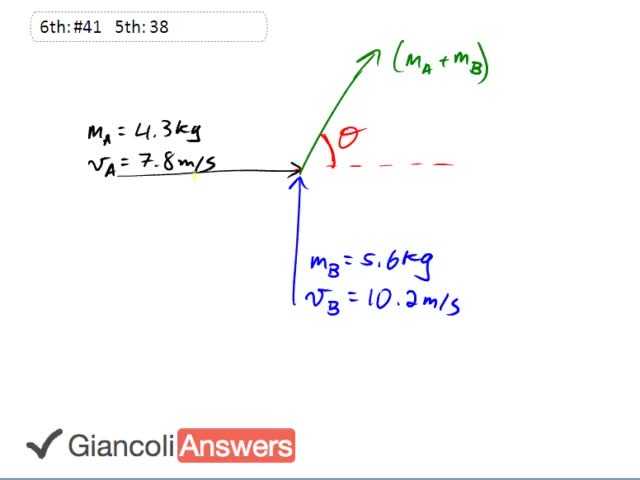

In order to watch this solution you need to have a subscription.
Two eagles are on a collision course and when they collide they’re going to hold on to each other so that their combined momentum will be along this green arrow and the mass of these, being considered as one object with mass ‘ma’ plus ‘mb’, the mass of each eagle. So since they’re approaching other at right angles we can say that the momentum of their combined mass after the collision is going to have the X-component equal to the momentum of the eagle along the black line and then the Y-component will be this momentum along the blue line. The momentum after the collision in the X-direction is going to be the momentum of the eagle a, and the momentum in the Y direction will be the momentum of eagle b. The momentum after the collision is going to be their combined mass, because they stick together times ‘v`’. Now we can find that using Pythagoras based on the X and Y-components. So we’ll say this is the same as the square root of ‘Px`’ squared plus ‘Py`’ squared. We’ll solve for ‘v`’:. ‘v`’ is the square root for ‘ma’ times ‘va’ squared plus ‘mb’ times ‘vb’ squared all divided by ‘ma’ plus ‘mb’. We can substitute in numbers at this point and get our answer: the square root of four point three kilograms times seven point eight meters per second, that’s all squared, plus five point six kilograms times ten point two meters per second, that’s all squared, divided by four point three kilogram plus five point six. This gives us a combined velocity, once they stick together their velocity will be six point six nine meters per second. Their direction, well tangent of theta is going to be the Y-component divided by the X-component of their momenta. So that’s ‘mb’ times ‘vb’ divided by ‘ma’ times ‘va’ and that equals five point six kilograms times ten point two divided by four point three kilograms times seven point eight and this gives us sixty degrees. So the final answer to this question is, the final velocity is six point seven meters per second, sixty degrees north of east. North of east is based on the way I do the picture.
Did you just leave out treating each component fully as a vector because the MA+MB is dropped or is this an alternate way to approach the problem? IE skipping fully doing the math of conservation of momentum through each vector...